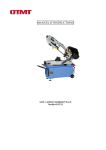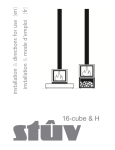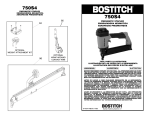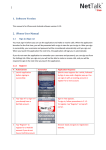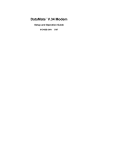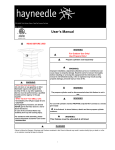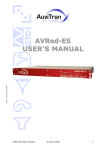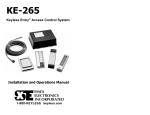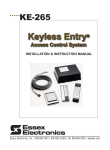Download Harbor Freight Tools 1 HP 7 In x 12 In Hydraulic Feed Metal Cutting Band Saw Product manual
Transcript
METAL CUTTING BANDSAW 7” X 12” Model 97009 Set up And Operating Instructions Diagrams within this manual may not be drawn proportionally. Due to continuing improvements, actual product may differ slightly from the product described herein. Distributed exclusively by Harbor Freight Tools®. 3491 Mission Oaks Blvd., Camarillo, CA 93011 Visit our website at: http://www.harborfreight.com Read this material before using this product. Failure to do so can result in serious injury. Save this manual. Copyright© 2007 by Harbor Freight Tools®. All rights reserved. No portion of this manual or any artwork contained herein may be reproduced in any shape or form without the express written consent of Harbor Freight Tools. For technical questions or replacement parts, please call 1-800-444-3353. TABLE OF contents Important Safety Information ...................................................................3 General Safety Rules.................................................................................4 Specific Safety Rules.................................................................................6 Grounding...................................................................................................8 Extension Cords.........................................................................................9 Symbology.................................................................................................10 Product Specifications.............................................................................10 Set Up Instructions....................................................................................11 Operating Instructions..............................................................................12 Maintenance and Servicing......................................................................25 Troubleshooting Guide.............................................................................29 Parts Lists..................................................................................................30 Assembly Diagrams..................................................................................38 Electrical Schematics...............................................................................43 Warranty Information................................................................................46 SKU 97009 For technical questions, please call 1-800-444-3353. Page Save This Manual Keep this manual for the safety warnings and precautions, assembly, operating, inspection, maintenance and cleaning procedures. Write the product’s serial number in the back of the manual near the assembly diagram (or month and year of purchase if product has no number). Keep this manual and the receipt in a safe and dry place for future reference. Important SAFETY Information In this manual, on the labeling, and all other information provided with this product: This is the safety alert symbol. It is used to alert you to potential personal injury hazards. Obey all safety messages that follow this symbol to avoid possible injury or death. Danger DANGER indicates a hazardous situation which, if not avoided, will result in death or serious injury. WARNING WARNING indicates a hazardous situation which, if not avoided, could result in death or serious injury. Caution CAUTION, used with the safety alert symbol, indicates a hazardous situation which, if not avoided, could result in minor or moderate injury. Notice NOTICE is used to address practices not related to personal injury. Caution SKU 97009 CAUTION, without the safety alert symbol, is used to address practices not related to personal injury. For technical questions, please call 1-800-444-3353. Page General Safety Rules WARNING! Read all instructions Failure to follow all instructions listed below may result in electric shock, fire, and/or serious injury. The term “power tool” in all of the warnings listed below refers to your line-operated (corded) power tool. SAVE THESE INSTRUCTIONS 1. Work area safety a. Keep work area clean and well lit. Cluttered or dark areas invite accidents. b. Do not operate power tools in explosive atmospheres, such as in the presence of flammable liquids, gases or dust. Power tools create sparks which may ignite the dust or fumes. c. Keep children and bystanders away while operating a power tool. Distractions can cause you to lose control. 2. Electrical safety a. Power tool plugs must match the outlet. Never modify the plug in any way. Do not use any adapter plugs with grounded power tools. Unmodified plugs and matching outlets will reduce risk of electric shock. b. Avoid body contact with grounded surfaces such as pipes, radiators, ranges and refrigerators. There is an increased risk of electric shock if your body is grounded. c. Do not expose power tools to rain or wet conditions. Water entering a power tool will increase the risk of electric shock. d. Do not abuse the cord. Never use the cord for carrying, pulling or unplugging the power tool. Keep cord away from heat, oil, sharp edges or moving parts. Damaged or entangled cords increase the risk of electric shock. e. When operating a power tool outdoors, use an extension cord suitable for outdoor use. Use of a cord suitable for outdoor use reduces the risk of electric shock. 3. Personal safety a. Stay alert, watch what you are doing and use common sense when operating a power tool. Do not use a power tool while you are tired or under the influence of drugs, alcohol or medication. A moment of inattention while operating power tools may result in serious personal injury. b. SKU 97009 Use safety equipment. Always wear eye protection. Safety equipment such as dust mask, heavy duty work gloves, or hearing protection used for appropriate conditions will reduce personal injuries. For technical questions, please call 1-800-444-3353. Page c. Avoid accidental starting. Ensure the switch is in the off-position before plugging in. d. Remove any adjusting key or wrench before turning the power tool on. A wrench or a key left attached to a rotating part of the power tool may result in personal injury. e. Do not overreach. Keep proper footing and balance at all times. This enables better control of the power tool in unexpected situations. f. Dress properly. Do not wear loose clothing or jewelry. Keep your hair, clothing and gloves away from moving parts. Loose clothes, jewelry or long hair can be caught in moving parts. 4. Power tool use and care a. Do not force the power tool. Use the correct power tool for your application. The correct power tool will do the job better and safer at the rate for which it was designed. b. Do not use the power tool if the switch does not turn it on and off. Any power tool that cannot be controlled with the switch is dangerous and must be repaired. c. Disconnect the plug from the power source and/or the battery pack from the power tool before making any adjustments, changing accessories, or storing power tools. Such preventive safety measures reduce the risk of starting the power tool accidentally. d. Store idle power tools out of the reach of children and do not allow people unfamiliar with the power tool or these instructions to operate the power tool. Power tools are dangerous in the hands of untrained users. e. Maintain power tools. Check for misalignment or binding of moving parts, breakage of parts and any other condition that may affect the power tool’s operation. If damaged, have the power tool repaired before use. Many accidents are caused by poorly maintained power tools. f. Keep cutting tools sharp and clean. Properly maintained cutting tools with sharp cutting edges are less likely to bind and are easier to control. g. Use the power tool and accessories in accordance with these instructions and in the manner intended for the particular type of power tool, taking into account the working conditions and the work to be performed. Use of the power tool for operations different from those intended could result in a hazardous situation. . Service a. Have your power tool serviced by a qualified repair person using only identical replacement parts. This will ensure that the safety of the power tool is maintained. SKU 97009 For technical questions, please call 1-800-444-3353. Page Specific Safety Rules 1. Maintain labels and nameplates on the tool. These carry important safety information. If unreadable or missing, contact Harbor Freight Tools for a replacement. 2. Make sure the Bandsaw is located on a flat, level, sturdy surface capable of supporting the weight of the tool, accessories, and workpieces. Always “chock” the Wheels to prevent the Bandsaw from accidentally moving. 3. Make sure the Table of the Bandsaw and surrounding area are clear with the exception of the workpiece to be cut. 4. Before using the Bandsaw, check to make sure the Saw Blade is properly mounted and in good condition. . Never stand on the Bandsaw. Serious injury could result if the Bandsaw is tipped or if the rotating Saw Blade is accidentally contacted. . Never attempt to cut more than one workpiece at a time. 7. When cutting a large workpiece, make sure its entire length is properly supported. If necessary, use a roller stand (not included). . Do not lean on the Bandsaw when the tool is in its upright position. 9. When moving the Bandsaw, always have its Head lowered to its horizontal position. 10. Allow the Saw Blade to rotate to full speed before feeding the Blade into a workpiece. When turning off the Bandsaw, allow the Saw Blade to spin down and stop on its own. Do not press against the Saw Blade to stop it. 11. To avoid injury, always wear ANSI-approved safety goggles and heavy duty work gloves when changing the Saw Blade. 12. The Saw Blade becomes hot while cutting. Allow the Blade to completely cool before handling. 13. Do not force the Saw Blade into the workpiece when cutting. Apply moderate pressure, allowing the Blade to cut without being forced. 14. Turn off the Bandsaw and allow the Saw Blade to completely stop if the Blade is to be backed out of an incomplete cut. 1. Never attempt to remove material stuck in the moving parts of the Bandsaw while it is plugged in and running. 1. Keep all safety guards in place and in proper working order. 17. Always adjust and position the Blade Guide Arm before starting the cut. SKU 97009 For technical questions, please call 1-800-444-3353. Page 1. When cutting magnesium, use soluble oils or emulsions (oil/water mix) as water only will greatly intensify any accidental magnesium chip fire. See your industrial coolant supplier for specific coolant recommendations when cutting magnesium. 19. Avoid unintentional starting. Prepare to begin work before turning on the tool. 20. Do not leave the tool unattended when it is plugged into an electrical outlet. Turn off the tool, and unplug it from its electrical outlet before leaving. 21. Use the Vise or other practical ways to secure and support the workpiece to the Support Plate. Holding the work by hand or against your body is unstable and may lead to loss of control, and personal injury. 22. This product is not a toy. Keep it out of reach of children. 23. The brass components of this product contain lead, a chemical known to the State of California to cause birth defects (or other reproductive harm). California Health & Safety Code 25249.5, et seq.) 24. People with pacemakers should consult their physician(s) before use. Electromagnetic fields in close proximity to heart pacemaker could cause pacemaker interference or pacemaker failure. In addition, people with pacemakers should: • Avoid operating alone. • Do not use with power switch locked on. • Properly maintain and inspect to avoid electrical shock. • Any power cord must be properly grounded. Ground Fault Circuit Interrupter (GFCI) should also be implemented – it prevents sustained electrical shock. 2. Some dust created by power sanding, sawing, grinding, drilling, and other construction activities, contains chemicals known [to the State of California] to cause cancer, birth defects or other reproductive harm. Some examples of these chemicals are: Lead from lead-based paints Crystalline silica from bricks and cement or other masonry products Arsenic and chromium from chemically treated lumber Your risk from these exposures varies, depending on how often you do this type of work. To reduce your exposure to these chemicals: work in a well ventilated area, and work with approved safety equipment, such as those dust masks that are specially designed to filter out microscopic particles. (California Health & Safety Code § 25249.5, et seq.) 2. The warnings, precautions, and instructions discussed in this instruction manual cannot cover all possible conditions and situations that may occur. It must be understood by the operator that common sense and caution are factors which cannot be built into this product, but must be supplied by the operator. SKU 97009 For technical questions, please call 1-800-444-3353. Page Save these instructions. Grounding WARNING Improperly connecting the grounding wire can result in electric shock. Check with a qualified electrician if you are in doubt as to whether the outlet is properly grounded. Do not modify the power cord plug provided with the tool. Never remove the grounding prong from the plug. Do not use the tool if the power cord or plug is damaged. If damaged, have it repaired by a service facility before use. If the plug will not fit the outlet, have a proper outlet installed by a qualified electrician. Grounded Tools: Tools with Three Prong Plugs 1. Tools marked with “Grounding Required” have a three wire cord and three prong grounding plug. The plug must be connected to a properly grounded outlet. If the tool should electrically malfunction or break down, grounding provides a low resistance path to carry electricity away from the user, reducing the risk of electric shock. (See 3-Prong Plug and Outlet.) 2. The grounding prong in the plug is connected through the green wire inside the cord to the grounding system in the tool. The green wire in the cord must be the only wire connected to the tool’s grounding system and must never be attached to an electrically “live” terminal. (See 3-Prong Plug and Outlet.) 3. The tool must be plugged into an appropriate outlet, properly installed and grounded in accordance with all codes and ordinances. The plug and outlet should look like those in the following illustration. (See 3-Prong Plug and Outlet.) 3-Prong Plug and Outlet SKU 97009 Outlets for 2-Prong Plug For technical questions, please call 1-800-444-3353. Page Double Insulated Tools: Tools with Two Prong Plugs 1. Tools marked “Double Insulated” do not require grounding. They have a special double insulation system which satisfies OSHA requirements and complies with the applicable standards of Underwriters Laboratories, Inc., the Canadian Standard Association, and the National Electrical Code. (See Outlets for 2-Prong Plug.) 2. Double insulated tools may be used in either of the 120 volt outlets shown in the preceding illustration. (See Outlets for 2-Prong Plug.) Extension Cords 1. Grounded tools require a three wire extension cord. Double Insulated tools can use either a two or three wire extension cord. 2. As the distance from the supply outlet increases, you must use a heavier gauge extension cord. Using extension cords with inadequately sized wire causes a serious drop in voltage, resulting in loss of power and possible tool damage. (See Table A.) 3. The smaller the gauge number of the wire, the greater the capacity of the cord. For example, a 14 gauge cord can carry a higher current than a 16 gauge cord. (See Table A.) 4. When using more than one extension cord to make up the total length, make sure each cord contains at least the minimum wire size required. (See Table A.) . If you are using one extension cord for more than one tool, add the nameplate amperes and use the sum to determine the required minimum cord size. (See Table A.) . If you are using an extension cord outdoors, make sure it is marked with the suffix “W-A” (“W” in Canada) to indicate it is acceptable for outdoor use. 7. Make sure the extension cord is properly wired and in good electrical condition. Always replace a damaged extension cord or have it repaired by a qualified electrician before using it. . Protect the extension cords from sharp objects, excessive heat, and damp or wet areas. SKU 97009 For technical questions, please call 1-800-444-3353. Page RECOMMENDED MINIMUM WIRE GAUGE FOR EXTENSION CORDS* (120/240 VOLT) NAMEPLATE AMPERES EXTENSION CORD LENGTH (at full load) 25 Feet 50 Feet 75 Feet 100 Feet 150 Feet 0 – 2.0 18 18 18 18 16 2.1 – 3.4 18 18 18 16 14 3.5 – 5.0 18 18 16 14 12 5.1 – 7.0 18 16 14 12 12 7.1 – 12.0 18 14 12 10 - 12.1 – 16.0 14 12 10 - - 16.1 – 20.0 12 10 - - - TABLE A * Based on limiting the line voltage drop to five volts at 150% of the rated amperes. Symbology Double Insulated Canadian Standards Association Underwriters Laboratories, Inc. V~ A Volts Alternating Current Amperes No Load Revolutions per Minute n0 xxxx/min. (RPM) SPECIFICATIONS Electrical Requirements Stock Capacity at 90° Blade Speeds (Feet Per Minute) Blade Size Teeth Per Inch Belt Type Miter Slot Width / Depth Hydraulic Ram Travel Base Mounting Holes Wheel Dimensions SKU 97009 120 V~ / 60 Hz / 16 Amps 1 HP Single Phase Motor / 1720 RPM Power Switch Type: Toggle Circuit Breaker: 18 Amps (Resettable) Power Cord Type: 14 AWG x 3C Plug Type: 120 Volt / 3-Prong / Grounded 7” (Round) / 7” x 12” (Rectangle) 90 FPM / 135 FPM / 195 FPM / 255 FPM 0.75” x 0.031” x 93” (Carbon Steel Blade) 6 TPI 3V-270 11/16” Wide / 9/16” Deep 5-5/8” 3/8” Diameter (Qty. 4) 5” Diameter x 1” Wide For technical questions, please call 1-800-444-3353. Page 10 Unpacking When unpacking, check to make sure that the item is intact and undamaged. If any parts are missing or broken, please call Harbor Freight Tools at the number shown on the cover of this manual as soon as possible. Set Up Instructions Read the entire Important Safety Information section at the beginning of this manual including all text under subheadings therein before set up or use of this product. WARNING Risk of accidental starting; resulting in serious personal injury. Turn the Power Switch of the tool to its “OFF” position and unplug the tool from its electrical outlet before assembling or making any adjustments to the tool. Note: For additional information regarding the parts listed in the following pages, refer to the Assembly Diagrams near the end of this manual. Assembly 1. NOTE: To assemble and locate the Bandsaw will require additional assistance and a proper lifting device. 2. After the Bandsaw and its accessories are unpacked, make sure its Head is lowered to its horizontal position. (See Figure A.) 3. With a proper lifting device, raise the Bandsaw approximately six inches off the floor surface. (See Figure A.) FIGURE A 4. Once the Bandsaw is lifted, insert the Wheel Rod (92-4) through the two holes located at the bottom/right side of the Stand (77S). Slide one Wheel (92-2) on each end of the Wheel Rod. Place one Washer (92-1) on each end of the Wheel SKU 97009 For technical questions, please call 1-800-444-3353. Page 11 Rod. Insert one Cotter Pin (92-3) through the hole in each end of the Wheel Rod. Make sure to bend the Cotter Pins to secure the Wheels in place. (See Figure B.) . Screw in the two Levelers (93) into the two threaded mounting holes located underneath the bottom/left side of the Stand (77S). (See Figure B.) . Carefully lower the Bandsaw to the floor surface. Then turn the two Levelers (93) clockwise or counterclockwise to properly level the Stand (77S). (See Figure B.) 7. Attach the Hand Rod (98-1) to the Stand Assembly (77S) using Screw (98-2), washer (98-3) and Hex Nut (98-4). See Diagram on page 39. FIGURE B STAND (77S) WHEEL ROD (92-4) WHEEL (92-2) WASHER (92-1) COTTER PIN (92-3) LEVELER (93) . NOTE: The Bandsaw is factory pre-wired to operate on a grounded, 120 volt system. However, if rewired, the Bandsaw is also designed to operate on a grounded, 240 volt system. For information about how to switch the electrical system from 120 volt to 240 volt, refer to the “Electrical Schematics” toward the end of this manual. WARNING! Only a qualified electrician should attempt to rewire the Bandsaw. Operating Instructions Read the entire Important Safety Information section at the beginning of this manual including all text under subheadings therein before set up or use of this product. Caution: Even though the unit is equipped with wheels and a carrying handle, always seek help when wheeling the unit around the shop. TO USE THE QUICK VISE 1. Place the workpiece between the Vise Jaws (9, 22) with the amount to be cut off extending out past the Saw Blade (251). (See Figure C, next page.) 2. The Bandsaw is equipped with a quick action Vise Jaw mechanism which allows you to instantly position the moveable Front Vise Jaw (9). (See Figure C.) SKU 97009 For technical questions, please call 1-800-444-3353. Page 12 3. To operate, turn the Hand Wheel (5S) counterclockwise 1/2 turn and move the Front Vise Jaw (9) to the desired position. Then tighten the Front Vise Jaw against the workpiece by turning the Hand Wheel clockwise. (See Figure C.) HAND WHEEL (5S) FIGURE C FRONT VISE JAW (9) REAR VISE JAW (22) HAND WHEEL (5S) 4. Setting up the Quick Vise for a straight (0°) cut: • Loosen the Screws (H) and (G) of Front Vise Jaw (F). • Turn the Hand Wheel (5S) counterclockwise by half a turn and slide back the Front Vise Jaw (9). • Loosen Screw (A and B) and note that Screw (A) should be in the slot which is parallel with the Rear Vise Jaw. • Rear Vise Jaw at the scale side should be aligned with the zero (0) on the rule. Tighten Screws (A and B). (See Figure D.) FIGURE D BASE (1) 22 C A D G . 9 H Note: Make sure “C” slot is free of casting flush so the vise can be positioned in all angles. B ORIGINAL POSITION (FOR 0° CUTTING) Setting up the Quick Vise an angle: • Remove Screws (A and B) from base of the Rear Vise Jaw (22). • Position (D) over (B) and attach the Screw and Washer (19 and 22) and attach Screw (B). • Attach Carriage Screw (17) onto Slot (C) through the curved slot in the Base (1). • Align edge of the Rear Vise Jaw with the indexing rule and tighten Screws at (B and C). (See Figure E.) SKU 97009 For technical questions, please call 1-800-444-3353. Page 13 FIGURE E A D B THE POSITION FOR AN ANGLE (90°) CUT. . Setting up the Quick Vise for cutting a 12” workpiece: • Remove both fasteners from the Rear Vise Jaw (22). • Position (B) over the outer threaded hole on the Base (1). • Position Slot (A) over the small rectangular opening across the Base (1). • Attach Screws (A and B). Align the lower edge of the Rear Vise Jaw (22) with the “0” index mark adjacent to the 16° degree setting. Tighten the screws. (See Figure F) FIGURE F A D B TO ADJUST THE STOP BLOCK For repeated cuts of pre-set lengths 1. Loosen the Thumb Screw (38) that holds the Stop Block (41) to the Stock Stop Rod (40). (See Figure G) 2. Adjust the Stop Block (41) to the desired length position. Then re-tighten the Thumb Screw (38). (See Figure G) SKU 97009 For technical questions, please call 1-800-444-3353. Page 14 FIGURE G WORKPIECE (NOT INCLUDED) THUMB SCREW (38) STOCK STOP ROD (40) STOP BLOCK (41) TO CONVERT THE BANDSAW FOR VERTICAL USE 1. NOTE: Notching, slitting, and contour work is best done with the Bandsaw in its vertical position. 2. Raise the Saw Head to its full vertical position, making sure it locks into position by turning the Cylinder’s (216) on/off valve to its “OFF” position (the spoke to be positioned cross the cylinder). (See Figure H.) FIGURE H CYLINDER (216) SKU 97009 For technical questions, please call 1-800-444-3353. Page 15 3. Remove the two Screws (266-7), and remove the Deflector Plate (266-3). (See Figure I.) DEFLECTOR PLATE (266-3) SAW BLADE (251) SCREWS (266-7) FIGURE I 4. Guide the Saw Blade (251) through the slot in the Vertical Saw Table (55-2), and secure it in position with the two Screws (266-7). (See Figure J.) VERTICAL SAW TABLE (55-2) SCREWS (266-7) FIGURE J TO ADJUST THE BLADE SPEED 1. When using the Bandsaw, always change the Saw Blade (251) speed to best suit the material being cut. The illustration below shows several settings for several types of materials. (See Figure K.) Material Speed (Feet Per Minute) Motor Pulley Saw Pulley Stainless Alloy Steels Bearing Bronze 90 FPM Small Largest Medium to High Carbon Steels Hard Brass or Bronze 135 FPM Medium Large Low to Medium Carbon Steel Soft Brass 195 FPM Large Medium Aluminum Plastic 255 FPM Largest Small SKU 97009 Belt Groove Used FIGURE K For technical questions, please call 1-800-444-3353. Page 16 2. To adjust the Saw Blade (251) speed, loosen the two Hex Nuts (304) and Hex Screws (307-2). Slide the Motor (300) forward to release tension on the Belt (208). (See Figure L.) BELT (208) FIGURE L HEX NUT (304) (REMAINING 3 HEX NUTS NOT SHOWN) MOTOR MOUNT PLATE (303) 3. Remove the Belt (208) from its two Pulleys (206, 296). Place the Belt onto the two Pulleys according to the Saw Blade (251) speed desired. Then move the Motor (300) back to its original position and secure in place by tightening the previously loosened two nuts and two screws. (See Figures L and M.) Saw Pulley Motor Pulley Speed (Feet Per Minute) 90 FPM 135 FPM FIGURE M 195 FPM 255 FPM 4. Verify belt tension by pressing the belt between the pulleys. Deflection should be about 3.8”. In time, the belt will stretch and loose its tension. Loosen the Hex Nut (302) and back off the Belt Tension Limiter Bolt (301). Turn the Belt Tension Limiter Bolt (301) against the Motor Mount Bracket (307) and tighten the Hex Nut (302). TO ADJUST THE BLADE GUIDE BEARINGS 1. IMPORTANT: Blade Guide Bearings (266-10) adjustment is a critical factor in the performance of the Bandsaw. It is always best to try a new Saw Blade (251) to see if it will correct poor cutting quality before attempting to adjust the Blade Guide Bearings. For example, if a Saw Blade becomes dull on one side sooner SKU 97009 For technical questions, please call 1-800-444-3353. Page 17 than the other, it will begin cutting crooked. A Saw Blade replacement will correct this problem, whereas Blade Guide Bearings adjustment will not. 2. If a new Saw Blade (251) does not correct the problem, check the clearance between the Saw Blade and Blade Guide Bearings (266-10) to obtain proper clearance. NOTE: There should only be a maximum of 0.001 clearance between the Saw Blade and Blade Guide Bearing. To obtain this clearance, adjust as follows: • The Blade Guide Bearings (266-10) are mounted to the Guide Pivot Assemblies (270S) and can be adjusted. (See Figure N.) • Loosen the Hex Socket Head Screw (269-9) while holding the Guide Pivot Assembly (270S) with an allen wrench (not included). (See Figure N.) • Position the Guide Pivot Assembly (270S) by turning it to the desired position of clearance. Then re-tighten the Hex Head Socket Screw (269-9). (See Figure N.) • Adjust the second Blade Guide Bearing (266-10) in the same manner. SAW BLADE (251) GUIDE PIVOT ASSY. (270S) HEX SOCKET HEAD SCREW (269-9) BLADE GUIDE BEARING (266-10) BLADE GUIDE BEARING (266-10) FIGURE N TO ADJUST THE BLADE TRACKING 1. Raise the Bandsaw to its full vertical position, making sure it locks in position by turning the Cylinder (216) to its “OFF” position. (See Figure H.) 2. Turn on the Bandsaw. The Saw Blade (251) is tracking properly when the back of the Blade is just touching the edge of the Idler Wheel (250-1) flange. The back of the Blade should not be rubbing against the flange. (See Figure O, next page.) 3. If adjustment is necessary, the Blade Guide Bearings (266-10) shoud be clear of the Saw Blade (251). (See Figure N.) 4. Loosen the upper Hex Head Screw (243) to a point where it is just barely snug. (See Figure O, next page.) SKU 97009 For technical questions, please call 1-800-444-3353. Page 18 . With the Bandsaw running, turn the Adjusting Hex Head Screw (240) until the Saw Blade (251) is tracking properly, making sure Blade tension is maintained by turning the Adjustable Blade Knob (245) clockwise. (See Figure O.) . Make sure to retighten the upper Hex Head Screw (243) when adjusment is complete. (See Figure O.) BLADE TENSIONER KNOB (245) FIGURE O HEX HEAD SCREW (243) ADJUSTING HEX HEAD SCREW (240) TO ADJUST THE BLADE TENSION 1. Turn the Blade Tensioner Knob (245) clockwise to increase tension on the Saw Blade (251). Turn the Knob counterclockwise to decrease tension on the Saw Blade. Correct tension is aquired when the Saw Blade does not slip on the Drive and Idler wheels (231S and 250-1). (See Figure O.) 2. NOTE: When the Bandsaw is not in use over long periods of time, release the tension on the Saw Blade (251). TO ADJUST THE FEED RATE Note: Feed rate is adjusted by the Bleed Valve above on/off valve of the cylinder. Turning the wheel clockwise slows down the arm’s movement. SKU 97009 For technical questions, please call 1-800-444-3353. Page 19 TO ADJUST THE BLADE GUIDE BRACKETS 1. The Adjustable Blade Guide Knob (261) is adjusted by loosening the Knob and sliding the Adjustable Bracket (269S) up or down to accommodate the width of the workpiece. (See Figure Q.) 2. The Adjustable Bracket (269S) should be set as close as possible to the workpiece, without interfering with the workpiece. (See Figure Q.) 3. Once the adjustment is made, make sure to retighten the Adjustable Blade Guide Knob (261). (See Figure Q.) ADJUSTABLE BRACKET (269S) FIGURE Q ADJUSTABLE BLADE GUIDE KNOB (261) TO FILL THE COOLANT TANK 1. NOTE: When cutting magnesium, use soluble oils or emulsions (oil/water mix) as water only will greatly intensify any accidental magnesium chip fire. See your industrial coolant supplier for specific coolant recommendations when cutting magnesium. 2. Remove the Hose (78) at the top of the Coolant Tank (82). Then slide the Coolant Tank out from under the Stand (77S) of the Bandsaw. (See Figure R.) 3. Fill the Coolant Tank to about 80% capacity with a clean, water-soluble coolant (not included). (See Figure R.) 4. Slide the Coolant Tank (82) back under the Stand (77S) of the Bandsaw. Then re-insert the Hose (78) through the top of the Coolant Tank. (See Figure R.) . IMPORTANT: The water-soluble coolant should be replaced as often as is necessary to keep metal debris in the coolant from clogging the hoses. SKU 97009 For technical questions, please call 1-800-444-3353. Page 20 FIGURE R HOSE (78) COOLANT TANK (82) BASIC BANDSAW OPERATION - VERTICAL POSITION 1. WARNING! • Always wear ANSI-approved safety impact eye goggles when operating the Bandsaw. Never wear loose fitting clothin. • When operating the machine, keep the Bandsaw Blade enclosure closed. • Do not plug the Power Cord into an electrical outlet until all necessary adjustments (as previously discussed in this manual) have been made. • Cut only flat workpieces when the Bandsaw is in its vertical position. Never attempt to cut pipes or other round objects with the Bandsaw in its vertical position. • Before cutting, turn on the Bandsaw and check for excessively loose Saw Blade (251) tension or machine vibration. If this is found, turn off the Bandsaw and correct the problem before using. • Always keep hands and fingers safely away from the cutting area. 2. Raise the Saw Head Assembly to its full vertical position, making sure it locks in place by turning the Cylinder (216) to its “OFF” position. (See Figure S.) 3. Check to make sure the Motor Toggle Switch (750S4) and Coolant Pump Toggle Switch (750S2) are both in their “OFF” positions. (See Figure S.) 4. Plug the Power Cable (500) into the nearest 120 volt, grounded, electrical outlet. NOTE: If the Bandsaw has been re-wired to operate on a 240 volt system then plug the Power Cord into the nearest 240 volt, grounded, electrical outlet. SKU 97009 For technical questions, please call 1-800-444-3353. Page 21 . Turn the Coolant Pump Fitting (91S) to its “OPEN” position. Then turn the Coolant Pump Toggle Switch (750S2) to its “ON” position. (See Figure S.) . Turn the Motor Toggle Switch (750S4) to its “ON” position. (See Figure S.) 7. Set the workpiece on the Vertical Saw Table (55-2), making sure to keep downward pressure on the workpiece throughout the cutting process. (See Figure S.) . When cutting a large workpiece, make sure its entire length is properly supported. If necessary, use a roller stand (not included) with a large workpiece. 9. Allow the Saw Blade (251) to turn up to full speed before feeding the workpiece into the Blade. (See Figure S.) 10. Feed the workpiece into the Saw Blade (251) gradually. Do not force the Bandsaw to remove material faster than it is designed to cut. (See Figure S.) FIGURE S SAW HEAD ASSY. COOLANT PUMP FITTING (91S) SAW BLADE (251) VERTICAL SAW TABLE (55-2) MOTOR TOGGLE SWITCH (750S4) COOLANT PUMP TOGGLE SWITCH (750S2) SKU 97009 CYLINDER (216) For technical questions, please call 1-800-444-3353. Page 22 11. Never attempt to remove material stuck in the moving parts of the Bandsaw while it is plugged in and running. Turn off the Bandsaw if the workpiece is to be backed out of an uncompleted cut. 12. Once the cut is made, turn the Motor Toggle Switch (750S4) to its “OFF” position. Turn the Coolant Pump Toggle Switch (750S2) to its “OFF” position. Turn the Coolant Pump Fitting (91S) to its “CLOSED” position. The unplug the Power Cord (500) from its electrical outlet. (See Figure S.) 13. Wait until the Saw Blade (251) comes to a complete stop. Then remove the workpiece and scrap material from the Vertical Saw Table (55-2). (See Figure S.) 14. Turn the Cylinder (216) to its “ON” position. Slowly lower the Saw Head Assembly to its horizontal position. Then turn the Cylinder to its “OFF” position to lock the Saw Head Assembly in place. (See Figure S.) BASIC BANDSAW OPERATION - HORIZONTAL POSITION 1. WARNING! • Always wear ANSI-approved safety impact eye goggles when operating the Bandsaw. • When operating the machine, keep the Bandsaw Blade enclosure closed. • Do not plug the Power Cord into an electrical outlet until all necessary adjustments (as previously discussed in this manual) have been made. • Before cutting, turn on the Bandsaw and check for excessively loose Saw Blade (251) tension or machine vibration. If this is found, turn off the Bandsaw and correct the problem before using. • Always keep hands and fingers safely away from the cutting area. 2. Turn the Cylinder (216) to its “ON” position, and raise the Saw Head to its full vertical position. Then turn the Cylinder to its “OFF” position to lock the Saw Head in place. (See Figure T, next page.) 3. Secure the workpiece in the Vise (9, 22) assembly. When cutting a large workpiece, make sure its entire length is properly supported. If necessary, use a roller stand (not included) with a large workpiece. (See Figure T, next page.) 4. If cutting several workpieces at the same length, you may wish to adjust the Stop Block (41) to the desired position. (See Figure T, next page.) . Check to make sure the Motor Toggle Switch (750S4) and Coolant Pump Toggle Switch (750S2) are both in their “OFF” positions. (See Figure T, next page.) SKU 97009 For technical questions, please call 1-800-444-3353. Page 23 . Plug the Power Cable (500) into the nearest 120 volt, grounded, electrical outlet. NOTE: If the Bandsaw has been re-wired to operate on a 240 volt system then plug the Power Cord into the nearest 240 volt, grounded, electrical outlet. 7. Turn the Coolant Pump Fitting (91S) to its “OPEN” position. Then turn the Coolant Pump Toggle Switch (750S2) to its “ON” position. (See Figure T.) . Turn the Motor Toggle Switch (750S4) to its “ON” position. (See Figure T.) 9. Turn the Cylinder to its “ON” position, and slowly lower the Saw Head until the Saw Blade (251) is just above the workpiece cut line. (See Figure T.) 10. Allow the Saw Blade (251) to turn up to full speed before feeding the Blade into the workpiece. (See Figure T.) 11. Through the Hydraulic Feed System, allow the Saw Arm to lower, while it gradually feeds the Saw Blade (251) into the workpiece. Do not force the Bandsaw to remove material faster than it was designed to cut. NOTE: The speed at which the Saw Arm moves downward may be increased or decreased by adjusting the Bleed Valve on the Cylinder (216). (See Figure T.) 12. Never attempt to remove material stuck in the moving parts of the Bandsaw while it is plugged in and running. Turn off the Bandsaw if the workpiece is to be backed out of an uncompleted cut. COOLANT PUMP FITTING (91S) FIGURE T SAW HEAD ASSY. MOTOR TOGGLE SWITCH (750S4) CYLINDER (216) COOLANT PUMP TOGGLE SWITCH (750S2) SKU 97009 For technical questions, please call 1-800-444-3353. Page 24 13. IMPORTANT: When in the horizontal cutting mode only, the Motor Toggle Switch (750S4) will automatically turn to its “OFF” position and shut off the Bandsaw’s Motor when the cut has been completed. (See Figure T.) 14. Once the cut is made, and the motor is switched off, turn the Coolant Pump Toggle Switch (750S2) to its “OFF” position. Turn the Coolant Pump Fitting (91S) to its “CLOSED” position. Then unplug the Power Cable (500) from its electrical outlet. (See Figure T.) 1. Wait until the Saw Blade (251) comes to a complete stop. Then raise the Saw Head to its full vertical position. Turn the Cylinder (216) to its “OFF” position to lock the Saw Head in place. Remove the workpiece from the Vise (9, 22) assembly and scrap material from the Base (1) of the Bandsaw. (See Figure T.) 1. Turn the Cylinder (216) to its “ON” position. Slowly lower the Saw Head to its horizontal position. Then turn the Cylinder to its “OFF” position to lock the Saw Head in place. (See Figure T.) Maintenance And Servicing WARNING Risk of serious personal injury from accidental starting or electric shock. Turn the Power Switch of the Bandsaw to its “OFF” position and unplug the tool from its electrical outlet before performing any inspection, maintenance, or cleaning procedures. Damaged equipment can fail, causing serious personal injury. Do not use damaged equipment. If abnormal noise or vibration occurs, have the problem corrected before further use. INSPECTION, MAINTENANCE, AND CLEANING 1. Before each use, inspect the general condition of the Bandsaw. Check for loose screws, misalignment or binding of moving parts, cracked or broken parts, damaged electrical wiring, and any other condition that may affect its safe operation. Do not use damaged equipment. 2. Before each use, inspect the Saw Blade (251). Using a dull Saw Blade will cause excessive wear on the Motor of the Bandsaw and will not produce a satisfactory cut. Replace with a new Saw Blade when needed. To replace the Saw Blade: • NOTE: Make sure to wear heavy duty work gloves to avoid accidental injury from the Saw Blade (251) when performing this procedure. SKU 97009 For technical questions, please call 1-800-444-3353. Page 25 • Turn the Cylinder (216) to its “ON” position, and raise the Saw Head to its full vertical position. Then turn the Cylinder to its “OFF” position to lock the Saw Head in place. (See Figure U.) • Open the Blade Back Cover (286S). (See Figure U.) • Release Saw Blade (251) tension by turning the Adjustable Blade Knob (261). (See Figure U.) • Slip the old Saw Blade (251) off the Idler Wheel (250S), Drive Wheel (231S), and Guide assemblies. (See Figure U.) • Place the new Saw Blade (251) between each of the Guide assemblies and around the Idler Wheel (250S) and Drive Wheel (231S). IMPORTANT: The teeth must be pointing downward toward the Motor. (See Figure U.) • Tighten the tension on the new Saw Blade (251) by turning the Adjustable Blade Tensioner Knob (261) in a clockwise direction. (See Figure U.) • Close the Blade Back Cover (286S). (See Figure U.) ADJUSTABLE BLADE KNOB (261) FIGURE U IDLER WHEEL (250S) UPPER GUIDE ASSY. SAW BLADE (251) BLADE BACK COVER (286S) LOWER GUIDE ASSY. DRIVE WHEEL (231S) 3. To lubricate the Worm Gear Shaft Assembly: The Worm Gear Shaft Assembly (202S) runs in an oil bath Gear Box Assembly (201S) and should not require an oil change more than once a year, unless the oil becomes contaminated or a leak occurs due to improper replacement of the Gear Box Cover. To change oil in the Gear Box Assembly: • Position the Saw Arm in the horizontal position. • Remove the four Hex Socket Head Screws, Gear Box Cover, and Gear Box Gasket. (See Figure V.) SKU 97009 For technical questions, please call 1-800-444-3353. Page 26 • Remove the old oil from inside the Gear Box Assembly (201S) and replace the oil using 140 weight gear oil (not included). The new oil should just come to the edge of the Gear Box (202-1). Do not overfill. (See Figure V.) • Replace the Gear Box Gasket, Gear Box Cover, and four Hex Socket Head Screws. (See Figure V.) HEX SOCKET HEAD SCREWS FIGURE V GEAR BOX ASSY. (201S) GEAR BOX COVER & GEAR BOX GASKET 4. To replace the coolant: Remove the Hose (78) at the top of the Coolant Tank (82). Then slide the Coolant Tank out from under the Stand (77S) of the Bandsaw. (See Figure W.) • Fill the Coolant Tank to about 80% capacity with a clean, water-soluble coolant (not included). (See Figure W.) • Slide the Coolant Tank (82) back under the Stand (77S) of the Bandsaw. Then re-insert the Hose (78) through the top of the Coolant Tank. (See Figure W.) • IMPORTANT: The water-soluble coolant should be replaced as often as is necessary to keep metal debris in the coolant from clogging the hoses. FIGURE W HOSE (78) COOLANT TANK (82) SKU 97009 For technical questions, please call 1-800-444-3353. Page 27 . To clean the exterior parts of the Bandsaw, use only a clean cloth and mild detergent or mild solvent to clean the body of the Saw. Do not immerse any electrical part of the machine in liquid. . CAUTION! All maintenance, service, and repairs not mentioned in this manual must only be performed by a qualified technician. PLEASE READ THE FOLLOWING CAREFULLY The manufacturer and/or distributor has provided the parts list and assembly diagram in this manual as a reference tool only. Neither the manufacturer or distributor makes any representation or warranty of any kind to the buyer that he or she is qualified to make any repairs to the product, or that he or she is qualified to replace any parts of the product. In fact, the manufacturer and/or distributor expressly states that all repairs and parts replacements should be undertaken by certified and licensed technicians, and not by the buyer. The buyer assumes all risk and liability arising out of his or her repairs to the original product or replacement parts thereto, or arising out of his or her installation of replacement parts thereto. SKU 97009 For technical questions, please call 1-800-444-3353. Page 28 TROUBLESHOOTING Adjust the speed and/or feed for the material being cut. 3. 3. 4. 4. 5. 5. 6. 6. SKU 97009 For technical questions, please call 1-800-444-3353. Page 29 PARTS LIST Part SKU 97009 Description Specifications Qty. For technical questions, please call 1-800-444-3353. Page 30 PARTS LIST - CONTINUED Part SKU 97009 Description Specification For technical questions, please call 1-800-444-3353. Qty. Page 31 PARTS LIST - CONTINUED Part Description Specifications Qty. Leveler SKU 97009 For technical questions, please call 1-800-444-3353. Page 32 PARTS LIST - CONTINUED Part SKU 97009 Description Specifications Qty. For technical questions, please call 1-800-444-3353. Page 33 PARTS LIST - CONTINUED Part Description Specifications Qty. Blade Tensioner Knob 0.032” x 3/4” x 93” - 10T SKU 97009 For technical questions, please call 1-800-444-3353. Page 34 PARTS LIST - CONTINUED Part Description Specifications Qty. 259 SKU 97009 For technical questions, please call 1-800-444-3353. Page 35 PARTS LIST - CONTINUED Part Description Specifications Qty. Belt Tension Limiter Bolt SKU 97009 For technical questions, please call 1-800-444-3353. Page 36 PARTS LIST - CONTINUED Part SKU 97009 Description Specifications Qty. For technical questions, please call 1-800-444-3353. Page 37 ASSEMBLY DIAGRAM SKU 97009 For technical questions, please call 1-800-444-3353. Page 38 ASSEMBLY DIAGRAM - CONTINUED SKU 97009 For technical questions, please call 1-800-444-3353. Page 39 ASSEMBLY DIAGRAM - CONTINUED SKU 97009 For technical questions, please call 1-800-444-3353. Page 40 ASSEMBLY DIAGRAM - CONTINUED SKU 97009 For technical questions, please call 1-800-444-3353. Page 41 ASSEMBLY DIAGRAM - CONTINUED SKU 97009 For technical questions, please call 1-800-444-3353. Page 42 SKU 97009 For technical questions, please call 1-800-444-3353. 240 VOLT 120 VOLT Yellow Yellow White 120 VOLT 240 VOLT ELECTRICAL SCHEMATIC Page 43 ELECTRICAL SCHEMATIC - CONTINUED SKU 97009 For technical questions, please call 1-800-444-3353. Page 44 ELECTRICAL SCHEMATIC - CONTINUED SKU 97009 For technical questions, please call 1-800-444-3353. Page 45 LIMITED 90 DAY WARRANTY Harbor Freight Tools Co. makes every effort to assure that its products meet high quality and durability standards, and warrants to the original purchaser that this product is free from defects in materials and workmanship for the period of 90 days from the date of purchase. This warranty does not apply to damage due directly or indirectly, to misuse, abuse, negligence or accidents, repairs or alterations outside our facilities, criminal activity, improper installation, normal wear and tear, or to lack of maintenance. We shall in no event be liable for death, injuries to persons or property, or for incidental, contingent, special or consequential damages arising from the use of our product. Some states do not allow the exclusion or limitation of incidental or consequential damages, so the above limitation of exclusion may not apply to you. This warranty is expressly in lieu of all other warranties, express or implied, including the warranties of merchantability and fitness. To take advantage of this warranty, the product or part must be returned to us with transportation charges prepaid. Proof of purchase date and an explanation of the complaint must accompany the merchandise. If our inspection verifies the defect, we will either repair or replace the product at our election or we may elect to refund the purchase price if we cannot readily and quickly provide you with a replacement. We will return repaired products at our expense, but if we determine there is no defect, or that the defect resulted from causes not within the scope of our warranty, then you must bear the cost of returning the product. This warranty gives you specific legal rights and you may also have other rights which vary from state to state. 3491 Mission Oaks Blvd. • PO Box 6009 • Camarillo, CA 93011 • (800) 444-3353 Record Product’s Serial Number Here: Note: If product has no serial number, record month and year of purchase instead. Note: Some parts are listed and shown for illustration purposes only, and are not available individually as replacement parts. SKU 97009 For technical questions, please call 1-800-444-3353. Page 46














































